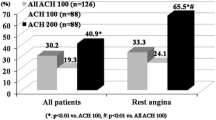Summary
In order to assess the role of α-adrenergic coronary tone in exercise-induced ischemia, 23 patients with chronic stable angina underwent, after coronary angiography, a symptom-limited supine exercise test on a cyclo-ergometer.
After recovery, either phentolamine (for the first nine patients) or indoramin (for the following nine patients) was directly injected into the most diseased vessel at identical doses (2 mg over 5 min). In the remaining 5 patients, a placebo was injected. Immediately thereafter the same exercise (identical workloads and exercise duration) was repeated. During exercise 1, heart rate (HR), mean blood pressure, and cardiac index increased by 51%, 23% and 33% in the phentolamine group, and by 45%, 15%, and 33% in the indoramin group.
After intracoronary injection of phentolamine or indoramin, control values (including pulmonary artery wedge pressure (PA wedge)) at rest did not change significantly. During exercise 2, HR, mean blood pressure, and cardiac index increased in a similar way; however, the increase in PA wedge was less pronounced (p < 0.01 in the phentolamine group and p < 0.05 in the indoramin group). ST-segment depression at the end of exercise 2 was significantly smaller for identical workloads and double products in the phentolamine group: 1.5 ± 0.3 mm vs 2.5 ± 0.3 mm (p < 0.01). However, these changes did not reach a statistical significance in the indoramin group: 1.7 ± 0.2 mm vs 2.0 ± 0.1 mm (NS). ST/HR slope in exercise 2 decreased by 51% (p < 0.01) in the phentolamine group and by 34% (p < 0.05) in the indoramin group. In the placebo group, exercise 2 was identical to exercise 1 and the ST/HR slopes were quite reproducible. These results show a less severe ischemic response after intracoronary α-blockade. Therefore, our results argue for a role of α-adrenergic coronary tone in exertional angina. The relatively higher efficiency of phentolamine vs indoramin suggests that α2-adrenergic mechanisms contribute to the inappropriate coronary vasoconstriction during exercise in these patients.
Access this chapter
Tax calculation will be finalised at checkout
Purchases are for personal use only
Preview
Unable to display preview. Download preview PDF.
Similar content being viewed by others
References
Berkenboom G, Abramowicz M, Vandermoten P, Degre S (1986) Role of alpha-adrenergic coronary tone in exercise-induced angina pectoris. Am J Cardiol 57, 195–198
Berkenboom G, Depierreux M, Fontaine J (1987) The influence of atherosclerosis on the mechanical responses of isolated human coronary arteries to substance P, isoprenaline and noradrenaline. Br J Pharmacol 92, 113–120
Berkenboom G, Fontaine J, Desmet JM, Degre S (1987) Comparison of the effect of beta-adrenergic antagonists with different ancillary properties on isolated canine and human coronary arteries. Cardiovasc Res 21, 299–304
Brown BG, Lee AB, Bolson EL, Dodge HT (1984) Reflex constriction of significant coronary stenosis as a mechanism contributing to ischemic left ventricular dysfunction during isometric exercise. Circulation 70, 18–24
Cohn PF (1987) Total ischemic burden: pathophysiology and prognosis. Am J Cardiol 59: 3C–6C
De Oliveria JM (1981) Three years experience with indoramin. Brit J Clin Pharmacol 12, 1115–1195
Deussen A, Heusch G, Thämer V (1985) Alpha2-adrenoceptor-mediated coronary vasoconstriction persists after exhaustion of coronary dilator reserve. Eur J Pharmacol 115, 147–153
Epstein SE, Talbot TL (1981) Dynamic coronary tone in precipitation, exacerbation and relief of angina pectoris. Am J Cardiol 48, 797–803
Förstermann U, Mügge A, Alheid U, Haverich A, Frolich JC (1988) Selective attenuation of endothelium-mediated vasodilation in atherosclerotic human coronary arteries. Circ Res 62, 185–190
Gage JE, Hess OM, Murakami T, Ritter M, Grimm J, Krayenbuehl HP (1986) Vasoconstriction of stenotic coronary arteries during dynamic exercise in patients with classic angina pectoris: reversibility by nitroglycerin. Circulation 73, 865–876
Kaltenbach M, Schulz W, Kober G (1979) Effects of nifedipine after intravenous and intracoronary administration. Am J Cardiol 44, 832–838
Langer SZ, Shepperson NB (1982) Recent developments in vascular smooth muscle pharmacology: the post-synaptic alpha2-adrenoceptor. Trends Pharmacol Sci 3, 440–444
Ludmer PL, Selwyn AP, Shook TL, Wayne RR, Mudge GH, Alexander RW, Ganz P (1986) Paradoxical vasoconstriction induced by acetylcholine in atherosclerotic coronary arteries. N Engl J Med 315, 1046–1051
McGrath JC (1982) Evidence for more than one type of postjunctional alpha-adrenoceptor. Biochem Pharmacol 31, 467–484
Moreland RS, Bohr DF (1984) Adrenergic control of coronary arteries. Federation Proc 43, 2857–2861
Mudge GH, Grossman W, Mills RM, Lesch M, Braunwald E (1976) Reflex increase in coronary vascular resistance in patients with ischemic heart disease. N Engl J Med 295, 1333–1337
Nabel EG, Ganz P, Gordon JB, Alexander RW, Selwyn AP (1988) Dilation of normal and constriction of atherosclerotic coronary arteries caused by the cold pressor test. Circulation 77, 43–52
Seitelberger R, Guth BD, Heusch G, Lee JD, Katayama K, Ross J Jr (1988) Intracoronary alpha2-adrenergic receptor blockade attenuates ischemia in conscious dogs during exercise. Circ Res 62, 436–442
Taylor SH, Sutherland GR, Mackenzie GJ, Staunton HP, Donald KW (1965) The circulatory effects of intravenous phentolamine in man. Circulation 31, 741–754
Toda N (1986) Alpha-adrenoceptor subtypes and diltiazem actions in isolated human coronary arteries. Am J Physiol 250: H718–H724
Author information
Authors and Affiliations
Editor information
Rights and permissions
Copyright information
© 1991 Springer-Verlag Berlin Heidelberg
About this paper
Cite this paper
Berkenboom, G., Unger, P. (1991). α-Adrenergic Coronary Constriction in Effort Angina. In: Heusch, G., Ross, J. (eds) Adrenergic Mechanisms in Myocardial Ischemia. Steinkopff, Heidelberg. https://doi.org/10.1007/978-3-662-11038-6_29
Download citation
DOI: https://doi.org/10.1007/978-3-662-11038-6_29
Publisher Name: Steinkopff, Heidelberg
Print ISBN: 978-3-662-11040-9
Online ISBN: 978-3-662-11038-6
eBook Packages: Springer Book Archive



